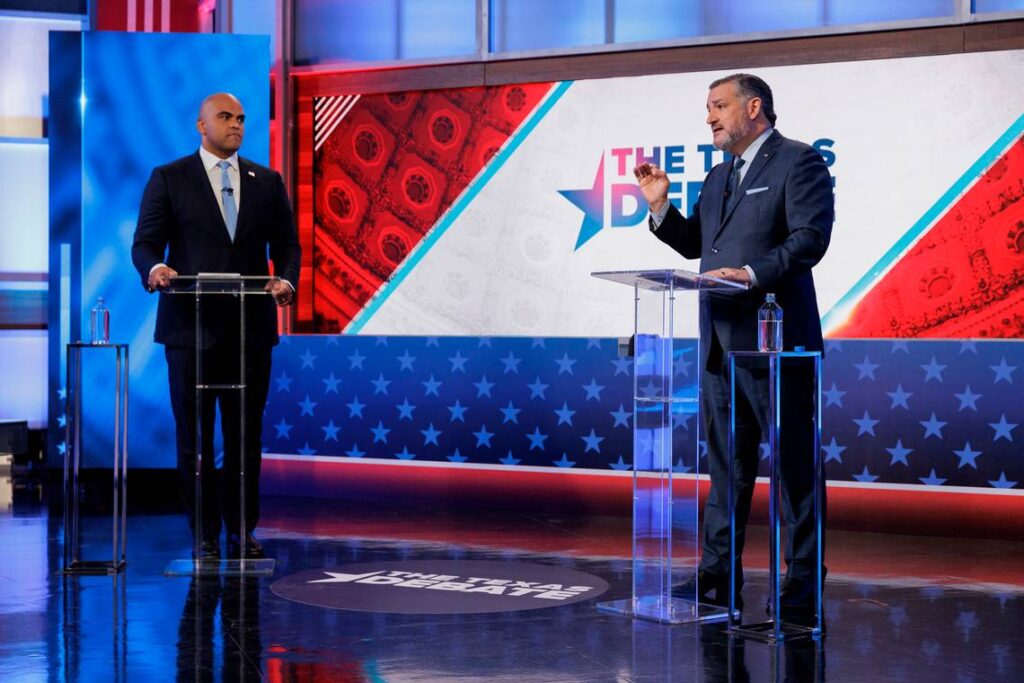After a prolonged period of escalating tension between Ted Cruz and Colin Allred, the two candidates for the U.S. Senate in Texas finally faced off in a high-stakes debate at WFAA-TV Studios in Dallas. This event was not only the sole debate of their campaign but also seen as a crucial opportunity to alter the dynamics of a closely contested race. Notably, Cruz expressed concerns about a lack of financial support from national Republicans, unlike the significant backing that Allred received from Senate Democrats. While Cruz is favored due to the Republican dominance in Texas and the likelihood of Donald Trump winning the state, Allred’s challenge lies in appealing to party defectors and mobilizing new voters — a daunting task given the existing political landscape.
While expectations were high, the debate likely did not deliver a definitive turning point for either candidate. The exchanges were marked by aggressive attacks and profound animosity, reflecting a race characterized by conflicting narratives and divided opinions. Partisans on both sides found satisfaction in the confrontational nature of the debate, which showcased the candidates’ hit lists of grievances against each other. Allred focused on Cruz’s controversial moments, such as his trip to Cancun during Texas’s winter storm and his actions on January 6th, while Cruz countered with criticisms of Allred on issues like immigration and economic management, frequently invoking the names of prominent Democrats like Joe Biden and Kamala Harris.
Despite their contentious interactions, both candidates attempted to present themselves as advocates of bipartisanship, although the effectiveness of these appeals varied. Allred’s ability to sway moderate Republicans is crucial for his campaign, necessitating a perception that he could work effectively across party lines. The debate also hit on pressing socio-economic issues that resonate deeply with Texas voters, including inflation, rising insurance premiums, and the cost of living, though the extent to which these discussions might resonate with undecided voters remains questionable.
In terms of who benefited from the debate, avid partisans on both sides were undoubtedly invigorated, akin to fans cheering for a favorite band playing iconic hits. Furthermore, the economic context—including inflation and steady price increases—was a prevailing theme, while Texas media outlets stood to gain from the ongoing expense of high-stakes advertising as the campaign progresses. The candidates’ contrasting approaches to the issues highlighted stark differences in their political strategies, with Cruz leaning heavily into rhetoric aimed at framing Allred as aligned with unpopularity among broader Democratic figures.
Conversely, several elements worked against the candidates, highlighting both weaknesses and tactical missteps. For instance, Cruz’s tactic of closely linking Allred with Kamala Harris appeared to undermine his broader image of bipartisanship, revealing a more contentious side of his campaign that received mixed reactions. Cruz’s attempts to adopt a gentler tone were soon overshadowed by aggressive confrontations on key issues, which may confuse undecided voters trying to assess his true political demeanor. Additionally, the scrutiny of voting records, while a traditional debate strategy, may have overwhelmed the average voter, making it hard for them to differentiate between the two candidates on these jarring issues.
Lastly, personal narratives eventually became talking points in the debate, with Allred referencing his athletic background to bolster his credentialing, while Cruz struggled to frame that narrative to his advantage. Cruz’s reliance on sports metaphors to critique Allred’s stances faced rebuttal from Allred himself, turning what was intended as criticism into an opportunity for jabs at Cruz’s own political standing. The overall tone of the debate ultimately left both candidates contending with their perceptions, navigating the tricky balance of highlighting policy achievements without alienating significant voter blocks in the process.
In summary, the debate served as a reflection of the bitter rivalry that has characterized Cruz and Allred’s campaign, underscoring their commitment to defending their respective positions while engaging in a heated exchange. As the candidates head into the final weeks of campaigning, each must hone their strategies to solidify their bases while reaching out to undecided voters, aware that every moment counts in the tense lead-up to the election. With the race still tightly contested, the importance of impactful messaging and responsive campaigning remains paramount for both parties, inviting continuous scrutiny from voters, political analysts, and media outlets alike as they seek to decipher the evolving landscape of Texas politics.

